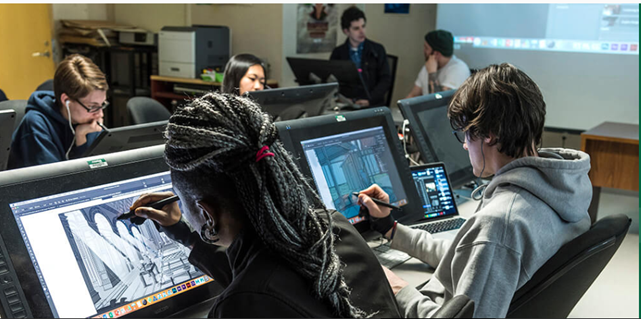动画写生 II
Animated sequences are created by caricaturing the movements of real human bodies. Students hone their sight measurement and gesture drawing skills. Landmarks of the human form are explored through the study of human anatomy. The identification and comprehension of the body’s muscles and bones allows students to create drawings that show a sense of accuracy and solidity of form. Warning: Nude models are used in all of our life drawing classes.
动画设计二
A good layout artist is able to evoke an emotional response from their audience. Students create more advanced layouts that include a firmer grasp of perspective drawing. Topics such as ellipses and exterior layouts are studied. Students work on storytelling by creating an exterior forest layout and an interior front hall with a stair case, which focuses on inclined planes.
动画实践与原理 II
Students investigate character movement by applying the basic principles of animation to more complex animated movements such as shifting weight and walks. Topics include squash and stretch, anticipation, follow-through and overlapping action, and appealing motion. Students study all aspects of animation using traditional and 2D tradigital tools.
动画绘画二
Students learn to develop the principles of animation to a higher level. Studies include animation of more complex actions. Body mechanics and action analysis are emphasized to raise students’ observation skills and understanding of complex movement. Traditional and 2D tradigital tools are utilized.
角色设计一
Designing characters with appeal, originality and emotion is a critical skill of a good character designer. By exploring different character designs and styles, students gain insight into the construction and structure of character design. Silhouetting, posing, acting, as well as creating character rotations elevate students’ drawing skills.
设计思维
Human-centred approaches are among the best methods of generating innovative solutions for people at work, at home or within your community. Design thinking is a user-centred method of creative problem solving applicable any time you need to generate new ideas. It is about embracing mindset shifts and tackling problems from the user’s perspective. Students learn the five-step process while involving the user each step of the way. Through research discussions and analysis, students work, first independently, then with a team, to emphasize with their users, define a problem, and then ideate, prototype and test an original solution that places people at the heart of a challenge.
动画剧本创作
Students are introduced to the basic concepts of screen writing. Students analyze animated and live-action stories to determine the characteristics of effective screenplays. Students also write their own eleven-minute screenplay featuring original, animated characters.
